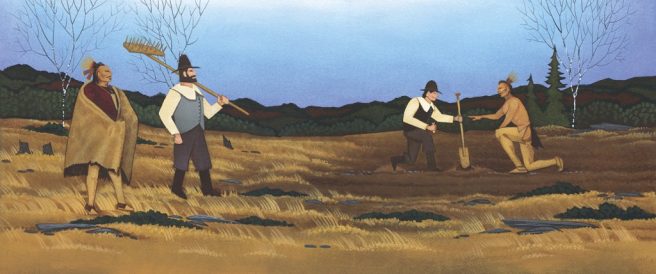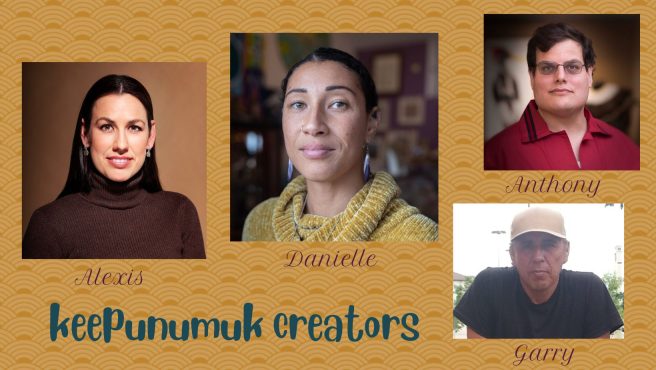
Did you know that while most Americans celebrate the fourth Thursday in November as a day of thanksgiving, many Native Americans consider it a day of mourning?
The Wampanoag had inhabited Southeastern Massachusetts for thousands of years before the Mayflower Pilgrims arrived in 1620. This illuminating new picture book tells the story of the first Thanksgiving from a Native American perspective.

We first hear a conversation between a contemporary Wampanoag grandmother, N8hkumuhs (NOO-kuh-mus), and her grandchildren Maple and Quill. They are curious to learn how Weeâchumun, the Guardian Spirit of Corn, asked their ancestors to help the Pilgrims.
“The first Thanksgiving?” Maple asked.
“Some people call it that,” N8hkumuhs said. “We call it Keepunumuk, the time of harvest. Here’s what really happened.”

Weeâchumun grew concerned when a large boat with white sails approached the shore one fall day. Who were these new people? Could she trust them? It had been two winters since many of the First Peoples who had cared for her had passed on to the Spirit World. Would this winter be her last? She called upon Fox to keep an eye on the newcomers.
As fall turned to winter, Fox watched the newcomers travel inland, enter the forest, and build homes on top of an empty village. Though they diligently searched for food, it was never enough, and many died from cold, starvation and disease. Unlike the others who’d come to hunt, fish, and trade years before, these newcomers seemed different: they were here to stay.

When spring arrived, Weeâchumun and her two sisters, Beans and Squash, awoke from their winter slumber. They pushed through the ground and reached for the sky as the sun warmed the earth.
Fox shared with them what he had seen: the newcomers could not source enough food to sustain themselves. They’d found some of Weeâchumun’s seeds, but they did not know how to help them grow.
But the newcomers could not hear the seeds. Their ears did not know the voices of the land.
Along with their animal friends (Deer, Duck, Turkey, Rabbit), the three plant sisters agreed to help the newcomers despite Fox’s skepticism. Rabbit reminded him that “The Creator tells us to help all living things. This is how the world works.”

So Weeâchumun sent dreams to the First Peoples with a message:
Bring me and my sisters to the newcomers.
They are hungry and need help.
Wampanoag leader Ousamequin visited the newcomers and introduced them to Tisquantum (Squanto), who showed them how to raise Weeâchumun, Beans and Squash, using fish and seaweed to help the corn grow.
The Three Sisters flourished; by the time fall arrived, Weeâchumun, Beans and Squash “brimmed with food.” The newcomers thanked the First Peoples for their help and prepared “a feast to celebrate their first year in their new home.” After hearing musket fire, Ousamequin and other First Peoples arrived, joining the feasting for three days.

N8hkumuhs finishes her tale by saying, “That meal changed both our lives and theirs forever. Many Americans call it a day of thanksgiving. Many of our people call it a day of mourning.” Maple notes that the story was different from what they had learned in school. She hadn’t realized it was Weeâchumun and “other beings of the land, sea, and sky” who had made the newcomers’ first harvest possible.
We learn more about what N8hkumuhs meant in an Endnote:
Many New England tribes think of the Thanksgiving holiday as a “Day of Mourning,” because the settlers brought disease and warfare that continue to take the lives of many indigenous people today.
History tells us that the Pilgrims didn’t actually invite the Wampanoag people who had helped them to their first harvest feast. The Wampanoag only showed up after misinterpreting the musket fire as a sign of warfare. When they learned the Pilgrims were celebrating the harvest, they joined in, bringing five deer to share.

When N8hkumuhs told Maple and Quill that the meal had been life changing for both the Wampanoag and the settlers, she was right. For her people, it meant the beginning of colonization and decades of disease, genocide, servitude, the loss of ancestral homelands, the marginalization of her people, and the misinterpretation of Wampanoag history.
In addition to the autumnal feast celebrating corn, the Wampanoag hold several other harvest feasts during the year (Strawberry Thanksgiving, Herring Day, Quahog Day). Today, the Wampanoag people as well as other First Peoples continue “to fight for their rights as sovereign Nations to practice their traditions, make their own laws, and live on their homelands.”

Keepunumuk: Weeâchumun’s Thanksgiving Story was woven together by four Native creators: Danielle Greendeer (Mashpee Wampanoag), Alexis Bunten (Alaska Native), Anthony Perry (Chickasaw), and illustrator Garry Meeches Sr. (Anishinaabe).
Meeches’s beautiful acrylic paintings, rendered in an earthy palette of browns, greens and blues, embody the essence of Wampanoag beliefs: spiritualism, harmony with nature, reverence for Mother Earth and all living things. Along with his stunning pictures of land, sea, and sky, I especially like how he portrayed the Three Sisters, dreamy female spirit guides with translucent bodies who seem to float in their gardens.

This is an important and much needed story that places Native people and nature at the center of Thanksgiving, dispelling the stereotypes many of us grew up with and continue to perpetuate. Instead of focusing on black and white Pilgrim outfits with buckle shoes and roast turkey clichés, why not invite children to view Thanksgiving as a time to practice empathy for all people and to honor the interconnectedness of nature?
While it’s common to cite the Pilgrims’ bravery in seeking a new life, we shouldn’t overlook the Wampanoag’s role in their survival, of making this first harvest feast possible to begin with, and the fact that the Pilgrims forcibly occupied someone else’s land.

The authors have struck a nice balance in telling this story – emphasizing the kindness and compassion of the Wampanoag people, yet sparing the youngest readers from the travesties that subsequently occurred. The question of why some Natives consider Thanksgiving a day of mourning may initiate more in-depth discussions among older readers about the consequences of colonization. Rather than reading a glossed-over version of the hard truths surrounding this account, they can be introduced to them in an age appropriate manner.
The book opens with a short sidenote about the Wampanoag people and their 12,000-year stewardship of the land, as well as a glossary of important Wôpanâak words featured in the story.

Rich backmatter includes Endnotes about the Wampanoag tribes, their storytelling tradition, harvest feasts, and tradition of giving thanks. There’s also a recipe for Nasamp, a traditional dish made from corn meal, nuts, and berries, and a photo of the real Maple and Quill!
Keepunumuk: Weeâchumun’s Thanksgiving Story belongs in every school library, and is a wise reminder to consider and respect other perspectives. Imagine introducing kids to Thanksgiving with this fresh retelling centered around foodways and the Three Sisters instead of the inaccurate Pilgrim-centric narrative. This year, let’s all rethink Thanksgiving. 🙂
*

KEEPUNUMUK: Weeâchumun’s Thanksgiving Story
written by Danielle Greendeer, Anthony Perry and Alexis Bunten
illustrated by Garry Meeches Sr.
published by Charlesbridge, August 2022
Historical Fiction Picture Book for ages 3-7, 32 pp.
*Includes Introductory Sidenote, Glossary, Endnotes and Recipe
**Starred Review** from Kirkus
***Junior Library Guild Gold Selection
AMAZON || BOOKSHOP
♥️ Visit the Keepunumuk Website for Curriculum Guides and author and illustrator profiles.
♥️ Download the Activity Guide from the publisher’s website.
♥️ Enjoy this conversation with editor Karen Boss and the three co-authors of the book:
*
♥️ Here is a webinar featuring Teaching Resources for Primary Grades (includes Alexis reading the story and discussion with Danielle and Anthony):
*Interior spreads text copyright © 2022 Danielle Greendeer, Anthony Perry and Alexis Bunten, illustrations © 2022 Garry Meeches Sr., published by Charlesbridge. All rights reserved.
**This post contains Amazon and Bookshop Affiliate links. When you purchase an item using these links, Jama’s Alphabet Soup receives a small referral fee at no additional cost to you. Thanks for your support.
***Copyright © 2022 Jama Rattigan of Jama’s Alphabet Soup. All rights reserved.

Thank you for the book rec, Jama. I need this book for my students and myself. I’ll order it for my library. This review pairs nicely with the free Scholastic Reads Podcast: ‘If You Lived During the Plimouth Thanksgiving Revisited’
https://podcasts.apple.com/us/podcast/scholastic-reads/id1067375356?i=1000585803014
LikeLiked by 1 person
Thanks for the Scholastic link — will check it out!
LikeLike
I am happy about this book and glad a truthful book about Native people and Thanksgiving from their perspective has been written and illustrated by Native people. I love the earthy colors and style of the illustrations. I also love how he painted The Three Sisters as spirits and that they’re on the front cover. I love how the story starts off with a Grandmother Wampanoag in the present day telling her grandchildren about the history of Keepununuk. This is such an important book and I love the messages the book gives. Thank you, Jama for your excellent review of this book.
LikeLiked by 1 person
Thanksgiving myths and stereotypes are gradually being dispelled thanks to books like these. I was happy to be introduced to more Native American creators (I hope to read Perry’s Chula the Fox next).
LikeLike
I just shared this special book on Monday, Jama, although my review is very short compared to your wonderful words for it. I got it from my library but now have my own copy for the girls. It is a beginning for the younger readers to learn about Thanksgiving’s true beginnings. One special time I had with my students when we traveled east was to spend a day with the Wampanoag people. We learned some of this history at that time and studied the past from their perspective. Thank you for sharing the beauty and importance of this book.
LikeLiked by 1 person
Awesome that you and your class spent time with the Wampanoag people. And I’m happy to hear you liked the book enough to purchase your own copy to share with your granddaughters.
LikeLiked by 1 person
Timely book, and sensitive and thoughtful review Jama, I’m looking forward to reading and sharing it with my family and friends, many thanks! 🍁🍂🦊
LikeLiked by 1 person
Hope you get to see the book soon, Michelle. I learned some new things from it. 🙂
LikeLike
I’m about to pick up my copy from the library, Jama. Looking forward to it even more now.
LikeLiked by 1 person
I know you’ll enjoy it!
LikeLike
Just about to pick up my copy at the library, Jama :).
LikeLiked by 1 person
This looks like an amazing book. I just put it on hold at my library. Thanks for a wonderful review.
LikeLiked by 1 person
Wish there had been more books like these when I was growing up. We had a totally different version of the first Thanksgiving before.
LikeLike
The traditional mainstream story of the Pilgrims and the first Thanksgiving contains some truth and some myths. This new story also contains myths and truths, though it’s also not the full history.
From Smithsonian magazine:
“Exposed to new diseases, the Wampanoag lost entire villages. Only a fraction of their nation survived. By the time the Pilgrim ships landed in 1620, the remaining Wampanoag were struggling to fend off the Narragansett, a nearby Native people who were less affected by the plague and now drastically outnumbered them.”
All so sad!
best…. mae at maefood.blogspot.com
LikeLike